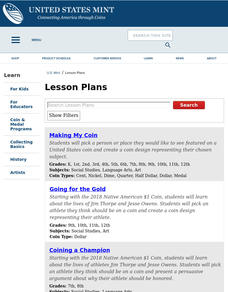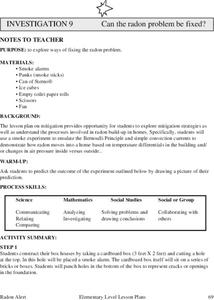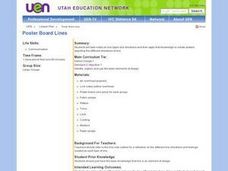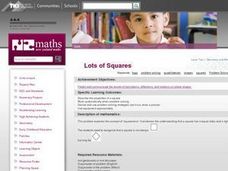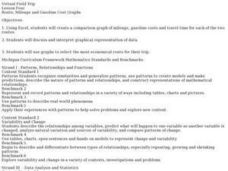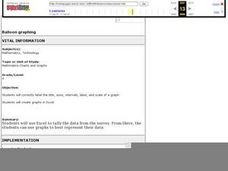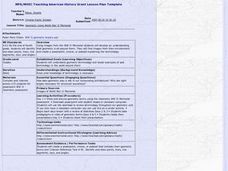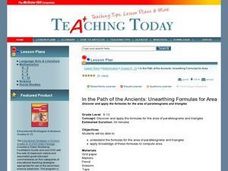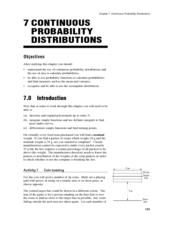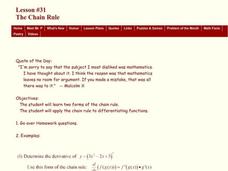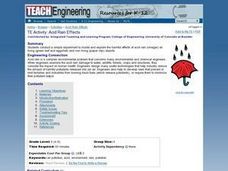Curated OER
Matching Pairs
Learners take turns matching the appropriate shapes (listing coin values) to those with numerical values listed on them. When students are successful, they win a blank shape for their collection.
Curated OER
Are You Money Smart?
Learners figure out and discuss the irony of this coin-centric poem. They also practice persuasive letter writing, and identify and count coin/money values.
Curated OER
Do You Have a Coin Collection?
Learners create a graph showing which young scholars in the class collect coins.
Curated OER
Do You Like to Spend or Save?
Learners, after briefly discussing spending and saving habits, take a poll to see how their peers like to manage money. Then students graph their findings and discuss the survey results.
Curated OER
Let's Clean the Beach!
Students volunteer their time to clean a local park. They estimate the amount of debris they collect and make observations. They write a poem and draw an illustration about their experience.
Curated OER
Where We Put Ourselves
Pupils examine the form and function of furniture in New Spain, explore the origins of marquetry, and discover the influences of other countries on marquetry in Puebla, Mexico.
Curated OER
"Slice of Pi with Neo-Excel"
Students explore diameter, radius, and circumference. They define radius, diameter, and circumference on an online dictionary, identify objects in the room with a radius and a diameter, and calculate the radius and diameter of various...
Curated OER
Can The Radon Problem Be Fixed?
Students participate in lab activities in which they examine the radon level in homes. They demonstrate through convection currents how radon moves through a home based on temperature. They predict what they believe will occur during the...
Curated OER
Interior Design: Poster Board Lines
Observe different types of lines and apply skills to create posters demonstrating line directions. Discern the four different types of lines and the ambience each creates in a room. In groups, explain each line poster.
Curated OER
Pede Patterns
Pupils generate number patterns for certain 'insects' from the mythical planet of Elsinore. Each 'Pede' is made up of square parts and has a number of feet. The patterns all link the number of feet and the number of squares. The students...
Curated OER
Lots of Squares
Students work in pairs, to make a square on the geoboards with a rubber band (or draw one on the dot paper). It can be any size and in any location and share their answers with the class.
Curated OER
Virtual Field Trip / Route, Mileage and Gasoline Cost Graphs
Students use a spreadsheet program to graph and compare milage, gasoline costs and travel time for two travel routes in their virtual field trip in Michigan. They determine the most economical route based on the graphs and calculations.
Curated OER
Balloon Graphing
Fourth graders explore data, charts and graphs. They create graphs using titles, labels, axes, intervals, and scale correctly. Students enter their data into Excel and create a graph.
Curated OER
Geometry of The World War II Memorial
Learners develop an appreciation of the use of geometry in our everyday world and structures. Students collect various picures and multimedia objcets that explain geometric principles and place them in a powerpoint presentation to be...
Curated OER
In the Path of the Ancients: Unearthing Formulas for Area
Students apply the formulas for the area of parallelograms and triangles. Through guided practice, students discover the correct way to apply the formulas. Working in pairs, they write their own problems featuring the formulas.
Curated OER
Continuous Probability Distributions
Students practice continuous probability distributions. In this probability activity, students calculate probability, use probability functions, and use rectangular distribution.
Curated OER
Lesson #67 Relative Extrema
Students test for relative extrema. In this Calculus lesson, 12th graders investigate the relative extrema of a function and sketch the curve from the given information without the use of a calculator.
Nazareth College
Create Your Own Tornado
Third graders identify key concepts and definitions about tornados. They work in small groups of three to four to create mini-tornados. After reading Tornado Alert as a class, 3rd graders discuss tornados and fill out a KWL chart.
Curated OER
The Chain Rule
Students determine the derivative of a function. In this determining the derivative of a function lesson, students use the chain rule to find the derivative of the function. Students use the chain rule to take the derivative...
Curated OER
Prime & Composite Numbers: Algebra/Geometry Institute 2009
Students create factor trees. In this prime and composite lesson, students model fractions using tiles. They create factor trees and identify prime and composite numbers. Students use grid paper and tiles to model...
Curated OER
Classroom Archaeology
Students, in groups, receive a box of artifacts. They record their findings and discuss what the items would have been used for. They come together at the end of the instructional activity to share their findings.
Curated OER
Acid Rain Effects
Get out the goggles and conduct a simple experiment to model and explore the harmful effects of acid rain (vinegar) on living (green leaf and eggshell) and non-living (paper clip) objects. Young chemists observe and describe the harmful...
Curated OER
"Old 300"
Fourth graders combine art and history to assess the importance of the "Old 300." They explore a group of colonists that Stephen F. Austin brought to Texas as the first settlers and then create a time line of major events leading to the...
Curated OER
Moth or Butterfly
Young scholars categorize butterflies and moths by identifying the unique characteristics of the two different species. In this classifying lesson, students discuss their prior knowledge about these insects before...


